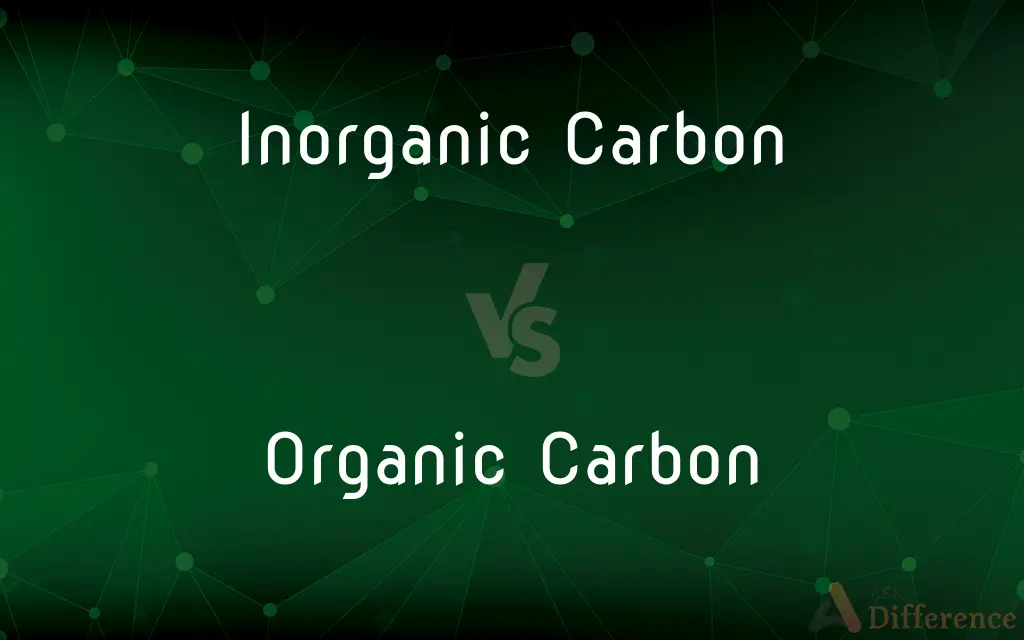Inorganic Carbon vs. Organic Carbon — What's the Difference?
By Tayyaba Rehman — Published on November 8, 2023
Inorganic Carbon refers to carbon compounds not containing carbon-hydrogen (C-H) bonds, while Organic Carbon pertains to carbon compounds primarily with carbon-hydrogen (C-H) bonds.

Difference Between Inorganic Carbon and Organic Carbon
Table of Contents
ADVERTISEMENT
Key Differences
Inorganic Carbon encompasses carbon forms without carbon-hydrogen bonds, often manifesting in simple compounds like carbon dioxide (CO2). On the contrary, Organic Carbon refers to molecules primarily characterized by carbon-hydrogen bonds, frequently seen in life forms.
In the realm of chemistry, Inorganic Carbon often appears in minerals and gases, such as carbonates and atmospheric CO2. Organic Carbon, however, is typically found in living organisms, representing the backbone of biomolecules like proteins, fats, and carbohydrates.
Inorganic Carbon sources, such as CO2 and bicarbonates, play pivotal roles in environmental processes, including the carbon cycle's abiotic segment. In contrast, Organic Carbon's role, evident in materials like plant matter, significantly influences the biotic segment of the carbon cycle.
Water systems like oceans house dissolved Inorganic Carbon, which is critical for aquatic photosynthesis. Organic Carbon in these systems primarily derives from life forms, such as plankton, vital for aquatic food webs.
Environmental studies often measure Inorganic Carbon to understand non-living carbon reservoirs and their influence on global carbon budgets. Comparatively, measuring Organic Carbon helps gauge the amount of carbon stored in life forms, offering insights into ecosystem productivity and health.
ADVERTISEMENT
Comparison Chart
Chemical Bonds
Lacks carbon-hydrogen (C-H) bonds.
Primarily has carbon-hydrogen (C-H) bonds.
Sources
Minerals, gases like CO2.
Living organisms and their remains.
Role in Environment
Influences abiotic segment of carbon cycle.
Central to biotic segment of carbon cycle.
Presence in Water
Dissolved form critical for aquatic photosynthesis.
From life forms, critical for aquatic food webs.
Study Importance
Gauges non-living carbon reservoirs.
Evaluates carbon in life forms, ecosystem health.
Compare with Definitions
Inorganic Carbon
Carbon forms in minerals and gases.
Limestone contains Inorganic Carbon in the form of calcium carbonate.
Organic Carbon
Carbon derived from living organisms in water.
Plankton in oceans are a primary source of Organic Carbon.
Inorganic Carbon
Dissolved carbon forms in water systems.
Seawater has dissolved Inorganic Carbon essential for marine life.
Organic Carbon
Indicative of ecosystem health and productivity.
High soil Organic Carbon suggests fertile, productive lands.
Inorganic Carbon
Measured to comprehend non-living carbon reservoirs.
Scientists study Inorganic Carbon levels to monitor atmospheric CO2.
Organic Carbon
Carbon compounds with carbon-hydrogen bonds.
Methane (CH4) is an example of Organic Carbon.
Inorganic Carbon
Carbon crucial for abiotic processes in the environment.
Inorganic Carbon in oceans assists aquatic photosynthesis.
Organic Carbon
Central to biotic processes in the carbon cycle.
Decomposing plant matter releases Organic Carbon back into the soil.
Inorganic Carbon
Carbon compounds lacking carbon-hydrogen bonds.
Carbon dioxide (CO2) is a common form of Inorganic Carbon.
Organic Carbon
Backbone of biomolecules in living entities.
Glucose, a sugar, contains Organic Carbon.
Common Curiosities
Why is Inorganic Carbon crucial for the environment?
It plays key roles in environmental processes, including the abiotic segment of the carbon cycle and aquatic photosynthesis.
Where can I find examples of Inorganic Carbon in nature?
In minerals, gases like atmospheric CO2, and dissolved forms in oceans.
What are typical sources of Organic Carbon?
Living organisms and their remains, such as plants, animals, and microbes.
How does Organic Carbon differ from Inorganic Carbon?
Organic Carbon primarily has carbon-hydrogen (C-H) bonds and is common in life forms, unlike Inorganic Carbon.
What's the significance of studying Inorganic Carbon in oceans?
It's crucial for understanding aquatic photosynthesis and the marine carbon cycle.
Are diamonds considered Inorganic Carbon?
Yes, diamonds are a form of Inorganic Carbon as they lack carbon-hydrogen bonds.
Why might researchers measure Organic Carbon in soils?
To evaluate soil health, fertility, and understand carbon storage in terrestrial ecosystems.
Is Inorganic Carbon always in gaseous form?
No, it can be found in solid forms like minerals or dissolved forms in water.
Is glucose an example of Organic or Inorganic Carbon?
Glucose is an example of Organic Carbon as it has carbon-hydrogen bonds.
What is Inorganic Carbon?
It refers to carbon compounds not containing carbon-hydrogen (C-H) bonds, like CO2.
How does Organic Carbon impact ecosystems?
It's central to the biotic segment of the carbon cycle and indicative of ecosystem health and productivity.
Can Organic Carbon turn into Inorganic Carbon?
Yes, through processes like respiration, where organisms convert organic molecules to CO2.
Is carbon dioxide (CO2) Organic or Inorganic Carbon?
CO2 is an example of Inorganic Carbon.
Share Your Discovery

Previous Comparison
Plums vs. Prunes
Next Comparison
YouTube vs. FacebookAuthor Spotlight
Written by
Tayyaba RehmanTayyaba Rehman is a distinguished writer, currently serving as a primary contributor to askdifference.com. As a researcher in semantics and etymology, Tayyaba's passion for the complexity of languages and their distinctions has found a perfect home on the platform. Tayyaba delves into the intricacies of language, distinguishing between commonly confused words and phrases, thereby providing clarity for readers worldwide.













































